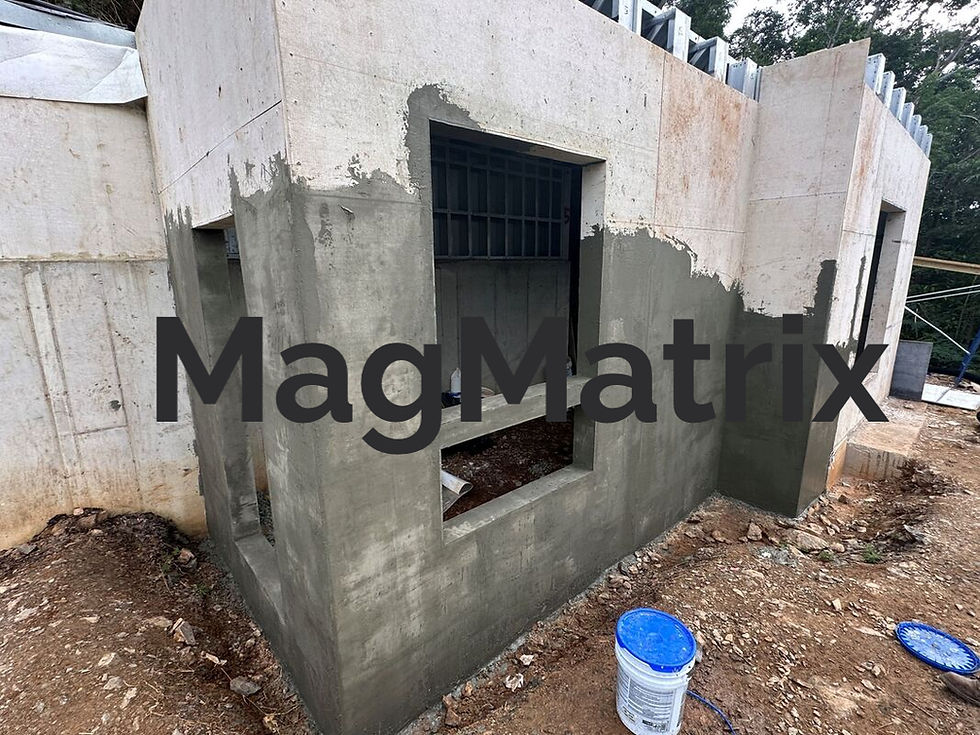Welcome to the world of Magnesium Oxide (MgO) Panels! --New MGO Sheathing Panel
- JP Group MagMatrix Brand
- Nov 11, 2024
- 4 min read
MgO cement is indeed a transformative material in construction. As sheathing panels, MgO brings together the strengths of wood, gypsum, and Portland cement panels while offering exceptional benefits such as:
Enhanced Structural Strength: MgO panels provide reliable support and stability, making them suitable for load-bearing applications.
Durability and Longevity: Resistant to mold, mildew, and rot, MgO panels have a longer lifespan than many other materials, especially in high-moisture environments.
Fire Resistance: MgO panels have superior fire resistance, meeting or exceeding code requirements in fire-rated assemblies, which gives them an advantage in safety-focused applications.
JP Group MagMatrix's brand MgO Panels have been engineered to maximize these benefits, making them some of the highest-performing sheathing panels on the market. They’re a solid choice for projects seeking durability, fire safety, and sustainability in one innovative package.
Explore further to see how MgO sheathing can transform your next project!

What is Magnesium Oxide (MgO)?
Magnesium oxide (MgO) is a versatile, naturally derived mineral used widely in construction due to its beneficial properties. MgO originates from magnesium ore, primarily from magnesite, dolomite, and brucite rock formations. Magnesium can also be extracted from seawater, making it a sustainable resource.
The process to create MgO involves several steps:
1. Extraction and Refinement: The raw materials are mined and processed to separate magnesium minerals, producing a purified magnesia powder.
2. Calcination: This powder is then heated (or “calcined”) to high temperatures, removing impurities and transforming them into MgO.
Properties of MgO
Raw magnesium is flammable and often used in fire starter flints, but the calcined MgO is highly fire-resistant and noncombustible.
MgO is recognized for its strength, durability, and environmental friendliness, making it an excellent material for construction applications, mainly as sheathing, flooring, and wall panels.
This transition from a flammable mineral to a fire-resistant compound makes MgO especially valuable in building materials, where safety, resilience, and sustainability are essential.
Magnesia Cement Types for MGO Sheathing Panels
Magnesia-based cement used in MgO panels is categorized into three types, each with unique properties suited for different construction needs:
1. Magnesium Oxychloride (MOC):
Known as Sorel cement, MOC is the most widely tested magnesia cement for panel products in the U.S. It’s valued for its mechanical strength, dimensional stability, flexural strength, and fire resistance at the very beginning stage of the panel installation for 1-3 years and its most significant problem is getting the strength drops dramatically after 1-3 years and also get corrosive on the steel frame stud or the screws and would not to be using as the structurally exterior sheathing panel.
MOC panels are similar to wood in workability and can be cut with traditional tools, making them user-friendly on construction sites.
MOC panels are commonly used in commercial and multifamily construction and offer enhanced durability, abrasion resistance, and stability, surpassing wood, gypsum, and Portland cement panels at the very beginning stage and then getting the strength of dramatic drops and collapsing down.
Magnesium Oxysulfate (MOS):
MOS provides fire resistance comparable to MOC but is less intense and durable in mechanical attachment and dimensional stability, especially when exposed to moisture.
While MOS panels work well in single-family residential settings and SIP (structural insulated panel) construction, they may degrade under prolonged moisture exposure unless carefully protected during installation. MOS is also known as the MGOSO4 mgo board formulation. If not curing well, it will lose strength drops soon, and it is also a misleading concept in the MGO board industry.
Regarding stability, MOS is generally less resilient than materials like fiber cement, plywood, and OSB.
3. BMSC 517 New Sulfate MGO Board:
Basic magnesium sulfate cement, also known as BMSC 517 new sulfate mgo cementitious, is a type of magnesium-based cement that incorporates magnesium sulfate rather than magnesium chloride. This cement type provides several advantages over traditional magnesia (MgO) cement, especially regarding moisture resistance and durability.
Key Characteristics:
Non-Corrosive: Unlike magnesium oxychloride (MOC) cement, which can cause corrosion when exposed to moisture, magnesium sulfate-based cement is not corrosive reinforcing materials like steel.
Moisture Resistance: Basic magnesium sulfate cement is more stable when exposed to moisture than MOC cement. It is less likely to absorb water or degrade in humid environments, making it suitable for various applications, including exterior uses.
Environmental Friendliness: Magnesium sulfate-based cement has a lower carbon footprint than traditional Portland cement, as it requires less energy for production and emits fewer greenhouse gases.
Strength and Durability: BMSC 517, a new sulfate mgo cementitious board, offers good mechanical strength, dimensional stability, and abrasion resistance, although it may not match the high flexural strength of magnesium oxychloride (MOC) in all applications.

Applications:
Basic Magnesium Sulfate Cement is often used in moisture-prone environments and for exterior sheathing and cladding applications where traditional MOC cement may not perform as effectively. It also has applications in subflooring, fireproofing, and partition walls.
This BMSC 517 new sulfate cementitious board is a promising choice for projects where long-term stability and reduced maintenance are key considerations, particularly in areas with high moisture or risk of exposure to water.
JP Group MagMatrix BMSC 517 new sulfate MgO board has developed full ranges of fire-rated structural wall sheathing, subfloor sheathing, and roof sheathing, all rated with the strength integrity at the same panel. We have fully developed the light gauge steel frame system and the timber frame systems, plus the SIP panels systems.

Comentarios